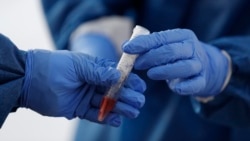ທ່ານນາງ ມິເຣວລ໌ ຄາມາຣິຊາ ນັກວິສະວະກອນຊີວະພາບໂມເລກຸນຂອງ UCLA ໄດ້ພັດທະນາການທົດສອບວັນນະໂລກແບບໃໝ່ ທີ່ແກ້ໄຂຂໍ້ບົກ ຜ່ອງຂອງການວິນິດໄສໂຣກວັນນະໂລກທີ່ມີຢູ່ແລ້ວ. ທ່ານນາງ ເຈເນຍ ດູລອດ ນັກຂ່າວ VOA ມີລາຍງານສຳລັບລາຍການ LogOn ປະຈຳອາທິດນີ້, ເຊິ່ງ ພຸດທະສອນ ຈະນຳເອົາລາຍລະອຽດມາສະເໜີທ່ານໃນອັນດັບຕໍ່ໄປ.
ທ່ານນາງ ມິເຣວລ໌ ຄາມາຣິຊາ ຊາວ ບູຣຸນດີ ເປັນວິສະວະກອນຊີວະພາບ ໂມເລກຸນ ຢູ່ທີ່ມະຫາວິທະນາໄລຄາລິຟໍເນຍ, ນະຄອນ ລອສ ແອນເຈີລິສ. ລາວໄດ້ຄິດຄົ້ນການທົດສອບທີ່ງ່າຍແຕ່ມີປະສິດທິພາບໃນການກວດຫາເຊື້ອວັນນະໂລກ.
ຜົງນ້ຳຕານນີ້, ເມື່ອປະສົມກັບນ້ຳ ແລະ ເສມຫະ ຫຼື ເລືອດຂອງຜູ້ປ່ວຍ, ຈະສາມາດກວດພົບເຊື້ອແບັກທີເຣຍ ທີ່ກໍ່ໃຫ້ເກີດພະຍາດປອດທີ່ຮ້າຍແຮງໄດ້ ພາຍໃນບໍ່ເທົ່າໃດຊົ່ວໂມງ.
"ຈຸດກຳເນີດຂອງໂຄງການທັງໝົດນີ້ ຄືແນວຄິດໃນການນຳສິ່ງທີ່ແບັກທີເຣຍອມັກກິນ, ໃນກໍລະນີນີ້ແມ່ນນ້ຳຕານ, ແລ້ວໃສ່ໂຕກວດຈັບຊີວະພາບ ຫຼື ຊີວະ ເຊັນເຊີ ລົງໄປ, ຈາກນັ້ນກໍເບິ່ງວ່າມັນໃຊ້ໄດ້ຫຼືບໍ່, ແລະ ປະກົດວ່າມັນໄດ້ຜົນ. ມັນເປັນສິ່ງທີ່ດີຫຼາຍ"
ການທົດສອບວັນນະໂລກທີ່ມີຢູ່ແລ້ວຍັງມີຂໍ້ບົກຜ່ອງ, ອາດໃຊ້ເວລາຫຼາຍອາທິດ, ເຊັ່ນການເພາະເຊື້ອ, ອາດໃຫ້ຜົນຜິດພາດເຊັ່ນ, ການຍ້ອມເສມຫະ ຫຼືມີລາຄາ ແພງເຊັ່ນ, ການທົດສອບລະດັບໂມເລກຸນ, ຕາມທີ່ທ່ານນາງ ເທຣຊີ ຈອນສັນ ຄະນະບໍດີວິທະຍາສາດຊີວິດຂອງ UCLA ໄດ້ກ່າວໄວ້.
ລາວ (ທ່ານນາງ ມິເຣວລ໌ ຄາມາຣິຊາ) ມຸ່ງເນັ້ນທີ່ຈະເຮັດໃຫ້ສີຍ້ອມນັ້ນມີຄວາມ ສະເພາະເຈາະຈົງ ແລະ ແຈ້ງຫຼາຍຂຶ້ນ, ເພື່ອໃຫ້ຕັ້ງແຕ່ກ້ອງຈຸລະທັດທົ່ວໄປ ທີ່ມີຢູ່ໃນສະຖານທີ່ເຊັ່ນ: ຄລີນິກພາກສະໜາມໃນອູການດາ...
ສາມາດກວດພົບໄດ້ໃນສະພາວະເຫຼົ່ານັ້ນ, ແລະ ນັ້ນເປັນສິ່ງທີ່ປ່ຽນແປງເກມ ໂດຍແທ້ຈິງ
ທ່ານນາງ ມິເຣວລ໌ ຄາມາຣິຊາ ໄດ້ກ່າວວ່າການທົດລອງຂອງລາວສະແດງ ໃຫ້ເຫັນວ່າ ແບັກທີເຣຍມີຊີວິດ ຫຼື ຕາຍ, ເຊິ່ງຊ່ວຍໃນການລະບຸວ່າບຸກຄົນນັ້ນ ສາມາດແຜ່ເຊື່ອໄດ້ຫຼືບໍ່. ແລະ ຍັງກວດພົບໄດ້ຢ່າງໄວວາ ວ່າຜູ້ປ່ວຍຕອບ ສະໜອງຕໍ່ການຮັກສາຫຼືບໍ່.
ແລະ ມັນຈະມີລາຄາບໍ່ແພງ.
ຜົງທີ່ເຮົາເຮັດນັ້ນມີຕົ້ນທຶນການຜະລິດທີ່ຕ່ຳຫຼາຍ // ໂດຍສະເພາະເມື່ອເຈົ້າ ຜະລິດໃນປະລິມານຫຼາຍ. ມັນຈະມີລາຄາໜ້ອຍກວ່າ 1 ໂດລາຕໍ່ການ ທົດສອບ.
ຕາມຂໍ້ມູນຂອງອົງການອະນາໄມໂລກ ມີຜູ້ເສຍຊີວິດຈາກພະຍາດວັນນະໂລກ 1.3 ລ້ານຄົນໃນປີ 2022. ທ່ານນາງ ຄາມາຣິຊາ ຫວັງວ່າການທົດສອບ ຂອງລາວຈະສາມາດຫຼຸດຜ່ອນຈຳນວນນີ້ລົງໄດ້ຢ່າງຫຼວງຫຼາຍ.
ອ່ານລາຍງານນີ້ເປັນພາສາອັງກິດ
Burundi native Mireille Kamariza is a molecular bioengineer at the University of California, Los Angeles. She came up with a simple yet effective test for the presence of tuberculosis bacteria.
This sugary powder, when mixed with water and a patient’s phlegm or blood, will within hours detect the bacteria that cause the deadly lung disease.
“The genesis of this whole project was the concept of taking something that bacteria love to ingest, sugar in this case, and then putting a biosensor on it, and then seeing if that works, and it did work. It was great.”
Existing TB tests have drawbacks. They can take weeks, like a culture test; can register false results, like a smear test, or are expensive, like a molecular test, says UCLA life sciences dean Tracy Johnson.
“She [Kamariza] is focused on making that dye more specific and brighter, so that even very common microscopes that are available in places like field clinics in Uganda ...
can even be detected in those circumstances, and that’s really a game changer.”
Kamariza says her test shows if the bacteria are alive or dead, which helps to determine if a person is contagious. And it quickly detects if a patient is responding to treatment.
And it will be inexpensive.
“The powder that we make is very cheap to make // especially when you make it on a grand scale. It’s going to be less than $1 a test.”
According to the World Health Organization 1.3 million people died from tuberculosis in 2022. Kamariza hopes her test will be able to significantly reduce this number.







ຟໍຣັມສະແດງຄວາມຄິດເຫັນ